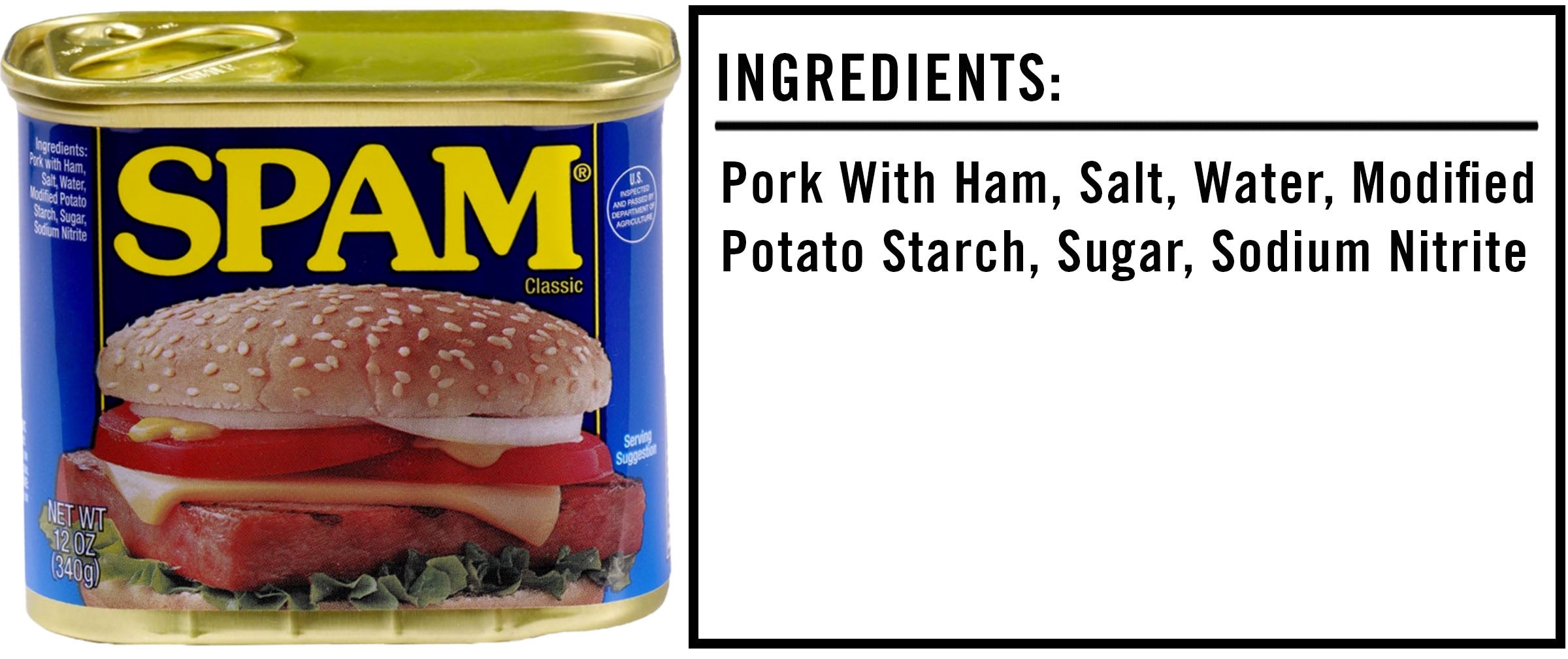We’re often told that you should never eat anything (or put anything on your body) if you don’t recognize everything on the ingredients list. But since most of us have no idea what xanthan gum or potassium benzoate are — or more importantly, what they’re doing to our bodies — we’re decoding the ingredients in the many things Americans put in (and on, or near) themselves with the help of an expert.
This edition: Spam, which is made from six separate ingredients that we’ve broken down in the exact order they appear online.

The Ingredients
1) Pork with Ham: Figuring out exactly what happens after a bunch of pigs are brought into a slaughterhouse and before they leave as a depressing pallet of Spam tins is near impossible. But evidence suggests that the meat in Spam is a combination of pork shoulder and ham, a leg cut preserved by curing.
As with most processed meat products, concerns about what goes on in the slaughterhouses that produce Spam are warranted. In a 2011 feature about the state of Hormel factories, where Spam is made, journalist Ted Genoways, author of The Chain: Farm, Factory and the Fate of Our Food, describes a harrowing image of pork manufacturing in general:
“Every hour, more than 1,300 severed pork heads go sliding along the belt. Workers slice off the ears, clip the snouts, chisel the cheek meat. They scoop out the eyes, carve out the tongue, and scrape the palate meat from the roofs of mouths. Because, famously, all parts of a pig are edible (‘everything but the squeal,’ wisdom goes), nothing is wasted.”
Though head meat goes into sausage, not Spam, you can see how virtually any meat coming from these massive factories could be less than decent. Plus, we already know that processed meats, like Spam, are considered to be carcinogenic. Just something to consider before cracking open a cold one… of Spam, that is.
2) Salt: Spam is perhaps most notable for its massive amounts of sodium, and the rumors are mostly true: One serving of Spam — a slice about the size of a McDonald’s hash brown — contains a whopping 790 milligrams. The American Heart Association recommends consuming no more than 2,300 milligrams of sodium per day, and in an ideal world, they say most adults should have no more than 1,500 milligrams — a single Spam musubi, for instance, would put you at about half the ideal daily amount. Too much sodium, of course, has been linked to high blood pressure, as well as increased risk for heart disease and kidney disease. So Spam-induced heart failure is a thing.
3) Water: This aids in mashing the various hog parts and other ingredients into one solid meat cube. Delish!
4) Modified Potato Starch: Modified potato starch is (obviously) extracted from potatoes, then treated physically, enzymatically or chemically to partially break down the starch. This can then be used as a batter to give foods a light, crispy texture. Or as the Spam website notes, “This helps keep moisture inside the meat, where it belongs.”
5) Sugar: Sugar can help with the caramelization process when cooking, which is something people who understand the beauty of a pan-fried, golden brown slice of Spam can attest to. They keep the sugar to a minimum, too: One serving shows zero grams on the nutrition label.
6) Sodium Nitrite: This is one of the big bad ingredients found in most processed meats. “Sodium nitrite stabilizes the red color in cured meats, which prevents the meat from naturally turning gray,” Dagan Xavier, ingredient expert and co-founder of Label Insight, told us while we were exploring the ingredients in frozen breakfast sandwiches. “Adding nitrite to food can lead to the formation of small amounts of nitrosamines (a carcinogen).” Booo!
The Takeaway
Look, I can appreciate a slice of Spam. Hell, I even crave the stuff from time to time. But the facts are, Spam is loaded with carcinogenic meat, brimming with sodium and laden with a preservative that could have deadly side effects. Moreover, Spam boasts virtually zero important vitamins and minerals.
I will say, however, that while Spam has a seriously bad reputation for being some kind of disgusting mystery meat, the sad truth is, most processed meats are just as tampered with. So I guess in that sense, Spam might not be as uniquely gross as you thought, but that says more about processed meat in general than about Spam specifically.
The best course of action is to keep your Spam intake to a minimum, which should be easy enough considering you probably thought eating the stuff was weird to begin with.

